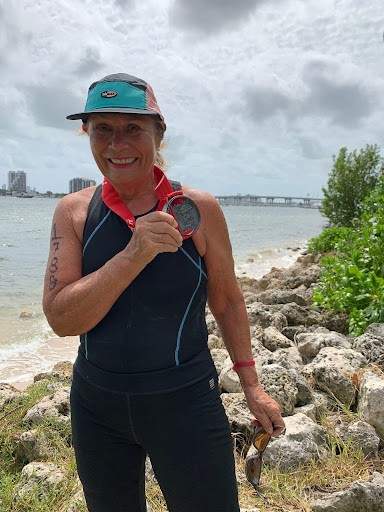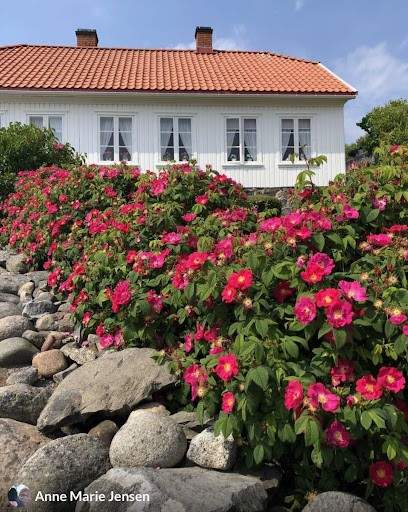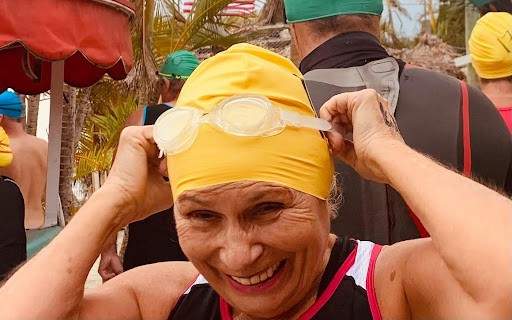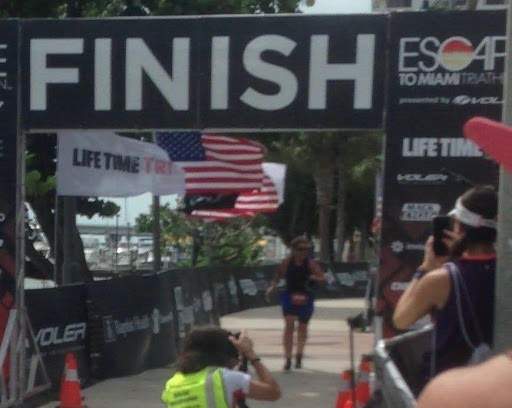How I Did a Triathlon at 69
Thursday, February 8, 2024
A boomer’s tale about pelvic organ prolapse, diapers, and a medal.

At 69, Annelie, with a big smile and a big Triathlon medal in 2019
“So, Dad tells me you are doing a Triathlon,” my son said.
I almost tripped on his eyeballs as they were rolling out of his head. Did I sense a touch of ageism?
My husband, who was in the room, looked sheepish and shrugged his shoulders. He knew he should not have said that. How could he? It was just one of my thousand dreams that had slipped out during an optimistic moment.
“Yes, I am,” I said, feeling a need to make a decisive statement. My words were now spoken and there was no way back.
Two minutes later, I sat down to google, “triathlons near me.” Sure enough, there were many. I paid the $100 dollars registration fee and signed up for an event to take place in September, in Miami.
Miami is a three hour drive from my hometown, Vero Beach, Florida. I figured, safe enough for not to see anyone I knew, or rather, safe enough for anyone not to see me.
At that time, I was still concerned about making a fool of myself.
With the triathlon event planned for September, I had almost two months to train.
How the triathlon event got on my radar
Long ago, I saw a photo of a group of women in triathlon suits, wearing big smiles and holding their even bigger medals. Those medals were huge.
“How cool”, I thought. “I would love to do that”, I wished, confirming the notion that I knew how to swim, how to bike, and how to run a little.
That was the end of that. I thought that was the end of that.
But, later I learned how the Universe keeps our wish lists safely tucked into the subconscious mind. It brews down there in the basement, until it is ripe for realization. Then it pops up to the surface, and the all mighty providence conspires to make it happen.
I had started a new exercise routine with swimming and biking a couple of years prior to the day my son mentioned the word triathlon.
Because I had undergone pelvic surgery, my regular Jazzercise classes were temporarily put on hold. They were replaced with physical activities that put less pressure on the pelvic floor.
From despair and ashes grow hopes and new dreams.
At age 65, shortly after I retired, I developed a health issue that was really, really, really hard.
It is not much talked about, because many women feel shame and embarrassment about the topic. It is called pelvic organ prolapse (POP). It is a condition that up to 50% of women will develop during their lifetime.
This is not the time and place for the POP story, but it is the background information needed for this story. Without the POP experience, my chance of doing a triathlon was pretty much close to zero.
But I want to touch on it because many women suffer from this condition in silence. I want them to know two things: they are not alone and treatments are available. Treatments vary, depending on which organ is affected, degree, and cause.
POP is more common among women, but men can also develop pelvic organ prolapse.
Reasons for experiencing POP are many. Some reasons include family history, vaginal childbirth, aging, carrying around extra weight, and prolonged pressure on the pelvic floor muscles.
In my case, I believe that thirty years of nursing practice, three children, age, and heavy lifting were main causes. The pelvic floor became too weak to handle the pressure of some organs.
At work, I took pride in being one of the strongest nurses in the ICU. Here patients are sick, dead weight, and heavy. But they had to be moved, in bed and out of bed.
Of course, lifting heavy hospital patients was a team effort. Nurses learn to use proper ergonomics for optimal body positioning. But with passing years and hard work, the body wears down, little by little.
At home, I took pride in being independent and strong when working around the house and garden. Gardening was and is my thing. I carried those heavy duty bags of garden soil like I was indestructible.
I still take pride in my strength. But, I have learned to ask for help when I need it. This is the best strength of all.
During the summer of my 65th year, we were getting ready to put our New York house on the market and move into my dream house in Florida. Every bit of strength I had was put into the tender loving care of my beloved garden.

Image taken, and permission for use given, by photographer Anne Marie Jensen.
I was saying goodbye to my beautiful trees and plants. In the heaven of my back yard, precious memories were stored. Looking around, I could see the footprints of my grandchildren playing, laughing, and enjoying life.
That summer, my heart felt heavy, as if full of rocks.
It was a heaviness that I carried around without relief. I wept for changes: present and impending, emotional and physical.
Realization of physical change in my physiology
Slowly, I noticed that my bathroom visits became more frequent. I had difficulty emptying the bladder. Other times I would just bend over to pick up something, and gushing Niagara Falls was pouring out.
It was not pleasant. But neither was it life threatening, nor was it painful.
For the first time, my body could not be trusted. I began wearing diapers, big times. That was not cool, and certainly not part of my retirement plans.
But I wore diapers until I found an experienced and wonderful urogynecological surgeon. He used a laparoscopic procedure to repair and restore the anatomy and physiology of my pelvic floor.
One day I will write about this experience, from A to Z.
The POP story deserves a time and place of its own; the time is soon, but the place is not here on Medium.
After the surgery, I started swimming and biking and walking for rehab. One day I was swimming in the community pool, oblivious to my surroundings. Suddenly I noticed a big splash in the water. I thought children were playing.
But no, no children were around. I was the only swimmer present. A full fledged storm was ranging under the dark Florida sky. High winds and pouring rain were dancing around the pool, and it scared the living daylight out of me.
Fast, like Speedy Gonzales, I swam like a crazy woman to get out of the pool. Never had I swam so fast. That is how I came to think I could do a triathlon. That is how I first uttered the T word, back in the safety of my home.
What triathlon is and why all boomers can benefit from the training

At 72, Annelie is getting ready to swim in a triathlon.
There are different triathlon distances. Most popular are Olympic, ironman, and sprint triathlon. The majority of beginners start with the sprint. So did I, and I never advanced to a longer distance. Regardless of what you choose, everyone has to swim, bike, and run.
The sprint triathlon consists of a Swim 0.5 miles (750 Meters), a bike ride 12.4 miles (20 KM), and a 3.1 miles run, which is 5K. These distances are doable for most people, even without tons of training.
I read and collected information about how the event takes place. Then I set up a weekly training schedule. Sunday and Thursday bike, Tuesday and Saturday swim, Monday, Wednesday, and Friday walk-run-walk.
This was not written in stone. Life happens between plans and we have to adjust and be flexible.
No urgency was put into these practices. It was a daily morning routine that I gave 30–60 minutes. No pressure about finishing time either. It was a self-made challenge. “You can do it, girl,” I told myself.
The most important reason why all boomers can benefit
Triathlon training has little to do with medals, and much to do with promoting cardiovascular health in our beautiful bodies.
As we grow older, becoming sedentary is a problem. That problem can cause tons of other problems. Chronic diseases, depression, isolation, and stiff muscles are some examples.
If we don’t physically move enough, we are not bringing blood with fresh oxygen and nutrients to the body parts that work together. Those body parts help us to perform activities of daily living.
Because the body and the mind are united, training for a triathlon makes us happy. The National Institute on Aging shows us how research supports the benefits of physical activity, on body and mind.
Without this, there would have been no Annelie participating in the upcoming September triathlon.
The September day for the Miami event arrived.
My hubby and I arrived at the venue on Saturday, the day before the event. The rain was pouring, the wind was strong, and a coconut fell from a tree, missing my head by an inch. Thank you dear God.
I received my race packet. It contained a race number, swim cap, free breakfast coupon, and little surprise goodies from sponsors. I parked the bike in the transition area, and found the place where the swim part should take place the following day. I was ready.
We then went to a beautiful Miami hotel to spend the night. After drying up and getting settled, we went downstairs to have dinner.
Get this, I had wine with my dinner. Can you believe this? Knowing I had to get up at 5am, to participate in my first triathlon, I still decided to drink wine with the meal.
So I did what I normally do, when I have more than one glass of wine; I wake up in the middle of the night. I got what I deserved, I woke up at 2:00 am. Not much sleep for someone who wants to be their own hero.
At 5:00 am in the morning of the triathlon event
Tired and out of sorts, I took a shower and donned my very cool triathlon suit, bought at Amazon.
For nutrition, I ate a banana on the way to the park. My muscles and liver had plenty of glycogen stored from dinner the night before. That glycogen is converted into energy when the body needs it.
At 6:00 am, I was at the park and joined hundreds, maybe a thousand other triathletes.
Now, it was do or die. I did not feel confident because I knew that I was not on top of my game. I huddled with the beginners and the seniors, who were grouped together. Then I waited for the swim event to be called.
I waited, made small talk with others, and waited. The swim event was finally on. I stalled for a minute when my group was called. Then I jumped in.
The instant I jumped into the water, I had a celestial experience. I had never had it before, and I have never had it again. The water embraced me, warm and comforting. All doubt was gone. I knew that I was going to be all right. I knew I would make it.
I jumped off a pier. Then I swam half a mile, parallel to the shore line. The water was choppy and I prayed all the way. I could see, and swam towards an orange colored FINISHING portal in the distance. Eventually I arrived, crawled out of the water, and I ran to the first transition and got my bike.
The bike was old, size junior, with a Norwegian flag on the bike frame. It was not the right size or the right bike for me, but it worked. It had a good tune up before the event to make sure that the brakes were optimal.
It was not easy. The water bottle slipped out of the holder at first attempt to drink. Crossing a bridge, I had to manage the elevation. Growing up in hilly Norway, I learned to ride up steep hills by riding from side to side, criss crossing. The same way we ski down hill, from side to side.
But that did not work here. I had to stay within my lane. And, I had to stay out of the way of other bikers. They all wanted to pass me.
The coming down on the other side of the bridge was fast and scary. It was so fast that I just had to trust in the Almighty and let it rip.
I was one of the last participants to enter the second transition, leave the bike, and run 3.1 miles.
The back of my right sneaker was digging into the heel. For every step that I ran and walked, excruciating pain hit my poor heel.
But I did it. Walking and running, running and walking.
At this point, I was so high on adrenalin that the pain did not bother me. Moving ahead was all that mattered.
Approaching the finishing stage, I lost my cap. The cap was from my grandson to use as a good luck charm. I found it, picked it up, and ran to the end. “And here she comes, 69 years young Annelie from Vero Beach,” I heard on the loud speaker as I limped across the finish line.

Annelie, at 69, crossing her first sprint triathlon FINISH line.
I did it.
The medal was big and beautiful. Everything worked out. The experience was just as cool as I had imagined it to be.
I thanked the Universe for all assistance, I thanked my body for its endurance, and I sent thankful thoughts to the surgeon who repaired my POP.
In conclusion, I sent a loving and grateful thought to my son. Unknowingly, he dared me do something that once was only a buried wish from long ago.
Thank you.
Now it is your turn. Start training. Participating in a triathlon event matters less than the training.
Take as long as you need. The older you are, the better it will serve you. The aging process can be messy, but training for a triathlon makes it better.
🇳🇴Annelie Holmene Pelaez believes that everyone has an attribute to share with others. Promoting cardiovascular health and helping adults over age 65 is her contribution. When we don’t let age define us, but rather empower us to grow, we discover health and happiness are byproducts of who we are.
Annelie is the author of the book, Say Yes to A Better Life, available at Amazon.





